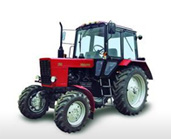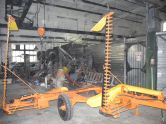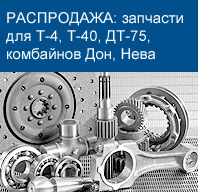 |
Bioenergy systems of agricultural production
THE WORLD’S FOOD SECURITY REDUCING FACTORS:
- In the beginning of XVIII century in the agricultural use there were 7.4 billion hectares of land, in 1960 with the population of 3 billion people there were 3.5 billion hectares, and in 2000 arable land amounted to only 0.27 ha of per capita. At the current degradation rate of 12 million hectares per year in 3-4 decades the planet will be able to provide with food no more than 2 billion people.
- Production of bioenergy resources in the last decade has increased by more than 3 times at the expense of food.
- According to FAO, the financial crisis hides the food crisis: in 2006 food prices have increased by 12%, in 2007 by 24%, in 2008 by 50% and according to experts of the UN and the Organization for Economic Cooperation and Development will remain high, despite the current conditions.
- Annual increase in food consumption in the world is 2%, and by 2030 the humanity will need 50% more food than at present.
- Every year more than 7 billion tons of CO2 are emitted in the atmosphere, which is accompanied by climate changes and adverse weather conditions for agriculture.
- According to the UN, in the today’s world nearly 1 billion people are starving.
The leading analysts say that a fundamental restructuring of the agricultural system is needed:
- The global energy crisis was extremely aggravated after passing the point of permanent reduction of the fossil fuel extraction, which will result in the large-scale conflicts for the control of the remains.
- The only way to prevent global hunger is planned and rapid restriction of the use of mineral fuel.
- Fundamental and all-embracing restructuring of the world’s bioenergy agricultural system is needed, ensuring the independence from non-renewable energy sources.
- The transition to such a system today requires unprecedented creative enthusiasm at all levels of society.
BALANCE OF OIL AND GAS IN UKRAINE
- The overall balance of primary energy consumption in Ukraine oil and gas occupy more than 60% of all used energy resources.
- Provision of the country with its own natural gas and oil in full is impossible.
- The gas production is 20 billion m3 per year with the consumption of 70-75 billion per year.
- Oil and gas condensate production is nearly 4 million tons, with the annual demand of at least 24 million tons.
- The current balance of fossil fuels in Ukraine can be considered as a snapshot of the future state of affairs globally.
In connection with this, an important task is to explore the possibilities of transformation of an agricultural system in the direction to the optimal combination of bioenergy production and food. In order to solve this problem, an analysis of characteristic scenarios of agricultural production was conducted on a farm with 20 hectares of land.
MODELS OF AGRICULTURAL PRODUCTION
- Model 1 - "Energy raw materials, 2 t/ha" – a modern production approach with the cultivation and alienation of energy raw materials from the agroecosystem.
- Model 2 - "Biodiesel, 800 l/ha" – cultivation of energy raw materials with its subsequent processing into biodiesel, methane and biohumus.
- Model 3 - "Biogas, 3000 m3/ha" - priority of production is in the crop rotation of green mass with its processing together with the waste into methane and biohumus, receipt of food grains and rapeseed for its own agrotechnological needs and 200 l/ha of biodiesel.
- Model 4 - "Food, 400 kg/ha" - priority of the production is finished livestock with processing of all waste into methane and biohumus, with the density of livestock equal to 1 conventional head per 1 ha of arable land and 200 l/ha of biodiesel.
- Model 5 - "Bioenergy agricultural production" (660 kg/ha of animal food, 350 l/ha of biodiesel, 2000 m3/ha biogas, 3.6 t/ha of biohumus) - similar to the previous model with a productivity, corresponding to organic fertilizer systems in stationary experiments under irrigation with the animal load of 1.5 conventional heads per 1 ha.
AGRICULTURAL PRODUCTION MODELLING WITH THE MODERN TECHNOLOGIES
- Information technology - computer simulation, information databases, Internet.
- Production of biogas - methane gas.
- Biohumus – accompaniment of the gas generation, organic disinfected fertilizer.
- Biologicals - nitrogen-fixing, phosphorus-mobilizing growth stimulants.
- Technology of production of liquid bio-fuels - methyl ester, ethanol.
- Modular technology of storing and processing of raw materials with gradual improvement of industrial structure.
- Modern energy-saving irrigation technologies.
INFORMATION FOR THE MODELING
- output of vegetable oil from rape seed - 40%;
- waste to flour ratio - 1:3.
- in the rape seeds contents of N - 3,5%, of P - 1.8% and of K - 1.0%;
- for 1 liter of milk needed 1 fodder unit, for 1 kg of meat - 8 fodder units of feed;
- cost of animal products (meat without bones and 30% fat cream) - $5/kg;
- meat to bones ratio is 4:1;
- yield factor of cream from milk - 0.1;
- bone meal and whey increase animal productivity by 10%;
- humidity of meal and bran is 15%, of green mass - 80%, of manure - 75%;
- 25 kg of bionitrogen are accumulated per 1 ton of perennial legumes dry biomass;
- biogas yield of 1 ton of meal – 550 m3, green mass – 160 m3, manure - 100 m3;
- biogas station capacity - 150 tons of biomass per year;
- weight of 1 m3 of biogas is 1.2 kg, the residue of decomposed organic matter - biohumus;
- CO2 content in the biogas is 30%, after purification it becomes methane;
- prices of products and fertilizers as of 02/15/2009
[ info@agrozakup.ru ]
|
 |

































